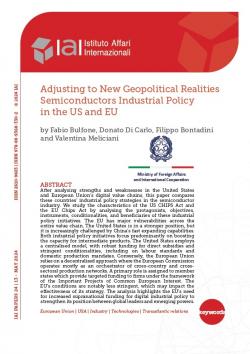Adjusting to New Geopolitical Realities Semiconductors Industrial Policy in the US and EU
After analysing strengths and weaknesses in the United States and European Union’s digital value chains, this paper compares these countries’ industrial policy strategies in the semiconductor industry. We study the characteristics of the US CHIPS Act and the EU Chips Act by analysing the protagonists, objectives, instruments, conditionalities, and beneficiaries of these industrial policy initiatives. The EU has major vulnerabilities across the entire value chain. The United States is in a stronger position, but it is increasingly challenged by China’s fast expanding capabilities. Both industrial policy initiatives focus predominantly on boosting the capacity for intermediate products. The United States employs a centralised model, with robust funding for direct subsidies and stringent conditionalities, including on labour standards and domestic production mandates. Conversely, the European Union relies on a decentralised approach where the European Commission operates mostly as an orchestrator of cross-country and cross-sectoral production networks. A primary role is assigned to member states which provide targeted funding to firms under the framework of the Important Projects of Common European Interest. The EU’s conditions are notably less stringent, which may impact the effectiveness of its strategy. The analysis highlights the EU’s need for increased supranational funding for digital industrial policy to strengthen its position between global leaders and emerging powers.
Revised version of a paper presented at the IAI Transatlantic Security Symposium 2023–24, held in Rome on 22 April 2024.
-
Details
Rome, IAI, May 2024, 19 p. -
In:
-
Issue
24|13 -
ISBN/ISSN/DOI:
978-88-9368-330-2
Introduction
1. The status quo ante: Strengths and weaknesses of the US and EU semiconductors value chains compared
2. Comparing the US CHIPS and EU Chips Act
2.1 The semiconductor industry: Some descriptive features
2.2 The politics of the US and EU industrial policies
2.3 The US CHIPS: Goals, main elements, funding and preliminary beneficiaries
2.4 The EU Chips: Goals, main elements, funding and preliminary beneficiaries
2.5 Conditionality in the US CHIPS Act
2.6 Conditionality in the EU Chips Act
Concluding reflections
References
Topic
Tag
Related content
-
Event21/05/2024
The Geopolitics of Transatlantic Economic and Technology Cooperation
leggi tutto -
Ricerca21/05/2024
Transatlantic Security Symposium - 15. ed.
leggi tutto -
Ricerca03/04/2024
La cooperazione economica e tecnologica UE-Usa di fronte alle nuove sfide geostrategiche e il ruolo dell'Italia
leggi tutto



